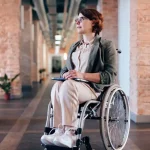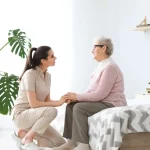Six Steps for a Senior Safe Bathroom
A safe bathroom is important for all family members, especially our aging parents. They may develop balance, endurance, and strength issues as they age. These issues can increase their chance of falling.
Falling is a leading cause of injury among our aging population. Every year, 2.5 million adults 65 and older are treated in emergency rooms after suffering injuries from falls, as reported by the Centers for Disease Control and Prevention.
A significant injury, such as a fractured bone or a head injury, results from a fall for one out of every five people.
Aging-in-Place
Most seniors prefer to live at home (called “aging-in-place”) in familiar surroundings where they’re comfortable. But as they age and their mobility lessens, falling becomes a primary concern for their safety.
A broken hip or serious fall injury could remove them from their cherished home and significantly reduce their quality of life.
If you have elderly parents, fall prevention should be a serious concern. This a very serious concern. Prevention is much better than patient rehabilitation.
Effective fall prevention requires an evaluation of the entire house. It’s best to evaluate each room’s use and the daily routines of your parents. The idea is for the whole house to be safe and functional.
Start with the Bathroom
The most important place to start is the bathroom.
Bathrooms have a reputation for being the most dangerous room in the house. They are full of hard surfaces and are wet and slippery.
That’s a bad combination. And they’re usually one of the busier rooms in the house; thus, the need for a senior-safe bathroom.
Providing a safe bathroom for elderly parents will involve the evaluation of both the facility and the person using the facility. A person’s abilities will direct the type and the application of modifications needed.
Consult an occupational therapist or a physical therapist to get recommendations about the senior’s physical and cognitive strengths and weaknesses.
A senior who uses a walker around the house has different modification needs than one who is mobile but has vision and hearing disabilities.
Here are some basic modifications you can accomplish to help provide a safe bathroom for all users.
Six Modifications for a Safe Bathroom:
- The bathtub/shower should have grab bars and a no-slip mat. The bars should be located at the correct height and location for the user and installed to be rigid and stable.
If the bar suddenly detaches, it could cause a fall. So read the manufacturer’s instructions about installation.
If you need more confidence, you should hire a professional to install it. A good installation is important. Don’t “cut corners” here. - Provide a shower chair and a hand-held shower wand for bathing. This is especially helpful for persons with balance issues.
For example, when they wash their face or hair, closing their eyes may cause imbalance.
Some medications may cause balance problems. If the issues are temporary, the shower chair can be removed and stored away until needed again. - An additional non-slip mat outside the tub/shower is important, helping provide a stable transfer in and out.
A word of caution: make sure the mat is not a trip hazard. If so, better to remove it when not bathing. - Suppose the bather still has trouble getting in and out of the tub, even with the above modifications.
In that case, you may consider a transfer bench. This will enable the user to sit outside the tub, then lift her legs over the tub side safely to enter or exit. - It can be difficult to get on and off the toilet. If you need help with this transfer, safety rails are provided.
A toilet seat elevated above the standard height may also be useful. - Improved lighting is always helpful. Replace and/or relocate fixtures throughout the pathways of a home.
Consider the lighting situation at night when sleepy heads go to the bathroom.
Improve your Chances
Unfortunately, there are no guarantees that even our best efforts will prevent all falls. However, prevention is still necessary.
Taking away dangers and giving help will make it easier for your loved one to stay safe, independent, and confident in their own home.

